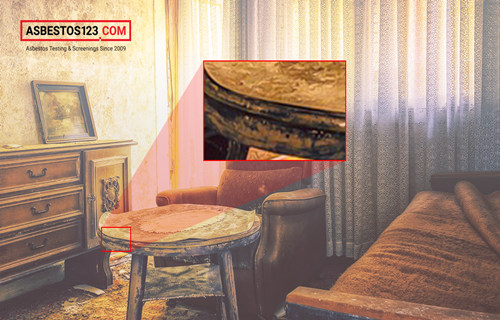Do Asbestos Fibers Settle on Furniture?

Asbestos was a common component of many building materials through the 1980s, and these hazardous materials can still be found in houses throughout the U.S. The presence of asbestos-containing materials in a home is not dangerous unless the material becomes damaged.
Deteriorating or friable asbestos that becomes dry and crumbles into powder may release asbestos dust and fibers into the air.
The shape and structure of asbestos fibers allow them to easily stick to surfaces.
The microscopic jagged fibers adhere readily to fabrics, hair, skin, and just about any surface. Microscopic particles can then settle on couch, chairs, desk, carpet, bed, and other pieces of furniture, where can remain in minute amounts until cleaned.
If an asbestos-containing material was improperly removed and disposed of, this could lead to the settled asbestos dust being disturbed in the future.
Suspended Asbestos Particles Will Eventually Settle
Asbestos fibers are very stable in the environment and remain in the dust indefinitely. As we've already mentioned above, asbestos fibers are very small and light and can be kept in the air very easily with minimal air movement. In time, they will settle, with the larger fibers settling first.
The major issue is that actions such as sweeping, dusting, or unfiltered vacuuming may result in asbestos fibers being re-suspended into the atmosphere. This is why it's so important that asbestos is removed carefully and professionally, as well as having an asbestos air quality test performed to remove all doubts.
People are more likely to experience asbestos-related diseases when they are exposed frequently and over long periods of time to higher concentrations of asbestos.
Health risks from asbestos exposure depend on a number of factors, including:
- how long the exposure lasts
- how often you were exposed
- the size and amount of the asbestos fibers
- the type of asbestos fibers
- the amount of time passed from the initial exposure
Hepa Filters Capable of Removing Asbestos From the Air
Removing the airborne asbestos dust and fibers is an important task, which is why many homeowners resort to using HEPA, which stands for high-efficiency particulate arrestor air filters in their respirators and air-purifying equipment.
Airborne asbestos fibers vary in size between 0.7 and 90 microns. HEPA air filters can capture particles as small as 0.3 microns with 99.97% efficiency. If the air cleaner uses an inferior HEPA-type filter, it would still have no trouble capturing the tiny toxic fibers.
Regardless of which types of HEPA filter, the air purifier must have airflow volume to cover an entire room, otherwise, there would not be enough airflow force to pull down the very lightweight fibers.
How to Clean Asbestos Settled Surface Dust From Your Home
- wipe all exposed areas with wet rags; this will help keep the dust from spreading as you clean;
- domestic vacuum cleaners should never be used to clean up asbestos dust;
- always use a vacuum cleaner equipped with HEPA filters to collect the asbestos-contaminated dust;
- clean thoroughly all textured surfaces - ensure that you get the deep-down dust, especially in the carpeting; vacuum them several times to make sure that you have gotten all the small particles;
- clean solid surfaces with regular cleaners, using damp rags or disposable wipes.
If you have concerns about settled asbestos dust in your home, don't hesitate to contact us.
